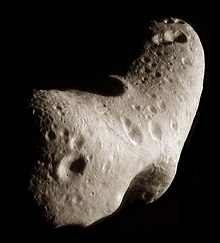S-type asteroid

S-type (stony-type or silicaceous-type) asteroids are asteroids with a spectral type that is indicative of a siliceous (i.e. stony) mineralogical composition, hence the name. They have relatively high density. Approximately 17% of asteroids are of this type, making it the second-most common after the carbonaceous C-type.
Characteristics
[edit]S-type asteroids, with an astronomical albedo of typically 0.20,[1] are moderately bright and consist mainly of iron- and magnesium-silicates. They are dominant in the inner part of the asteroid belt within 2.2 AU, common in the central belt within about 3 AU, but become rare farther out. The largest are 3 Juno (about 240–250 km across) and 15 Eunomia (230 km), with other large S-types being 29 Amphitrite, 532 Herculina and 7 Iris. These largest S-types are visible in 10x50 binoculars at most oppositions; the brightest, 7 Iris, can occasionally become brighter than +7.0, which is a higher magnitude than any asteroid except the unusually reflective 4 Vesta.
Their spectrum has a moderately steep slope at wavelengths shorter than 0.7 micrometres (μm), and has moderate to weak absorption features around 1 μm and 2 μm. The 1 μm absorption is indicative of the presence of silicates (stony minerals). Often there is also a broad but shallow absorption feature centered near 0.63 μm. The composition of these asteroids is similar to a variety of stony meteorites which share similar spectral characteristics.
Due to their volatile-poor (rocky) composition, S-type asteroids have relatively high density. A survey of 11 S-type asteroids found an average density of 3.0 g/cm3.[2]
S-group asteroids
[edit]SMASS classification
[edit]In the SMASS classification, several generally "stony" types of asteroids are brought together into a wider S-group which contains the following types:
- A-type
- K-type
- L-type
- Q-type
- R-type
- a "core" S-type for asteroids having the most typical spectra for the S-group
- Sa, Sk, Sl, Sq, and Sr-types containing transition objects between the core S-type and the A, K, L, Q, and R-types, respectively. The entire "S"-assemblage of asteroids is spectrally quite distinct from the carbonaceous C-group and the often metallic X-group.
Tholen classification
[edit]In the Tholen classification, the S-type is a very broad grouping which includes all the types in the SMASS S-group except for the A, Q, and R, which have particularly strong "stony" absorption features around 1 μm.
Stony asteroid families
[edit]Prominent stony asteroid families with their typical albedo are the:[1]
- Eos family (0.14)
- Eunomia family (0.21)
- Flora family (0.24)
- Koronis family (0.24)
- Nysa family (0.20)
- Phocaea family (0.23)
See also
[edit]References
[edit]- ^ a b "Asteroid Lightcurve Database (README) – 2. Taxonomic Class, orbital class, and albedo". LCDB. Archived from the original on 16 November 2015. Retrieved 16 February 2018.
- ^ P. Vernazza et al. (2021) VLT/SPHERE imaging survey of the largest main-belt asteroids: Final results and synthesis. Astronomy & Astrophysics 54, A56
- Bus, S. J.; Binzel, R. P. (2002). "Phase II of the Small Main-belt Asteroid Spectroscopy Survey: A feature-based taxonomy". Icarus. 158 (1): 146–177. Bibcode:2002Icar..158..146B. doi:10.1006/icar.2002.6856. S2CID 4880578.
